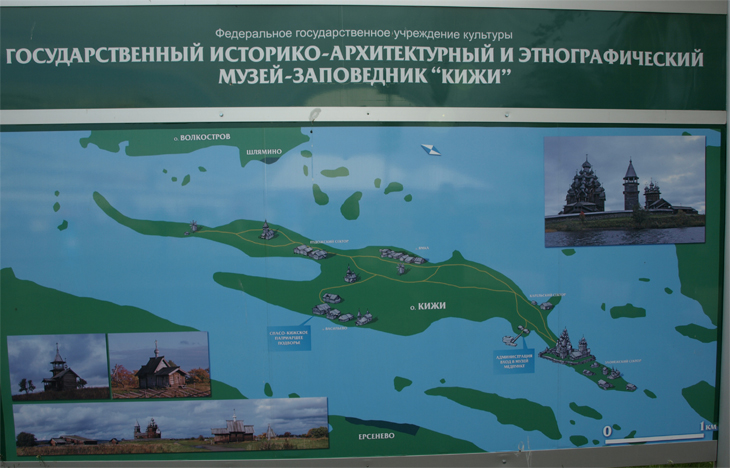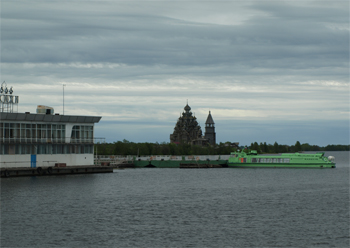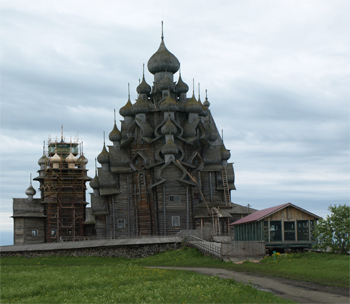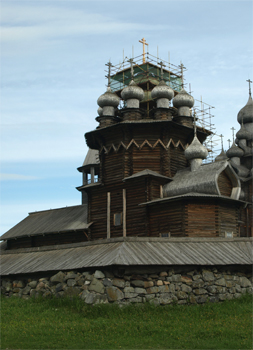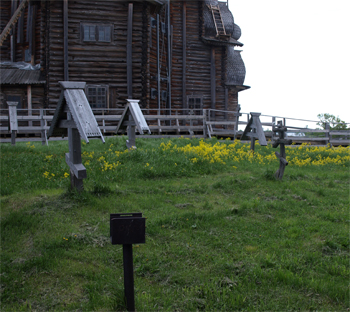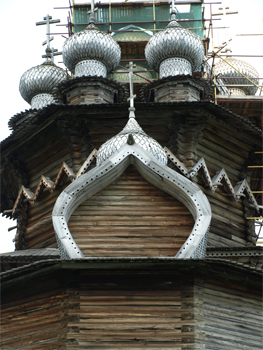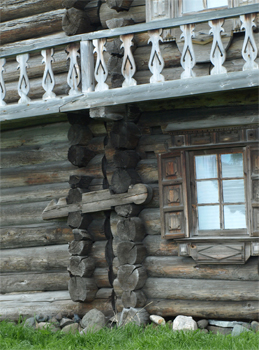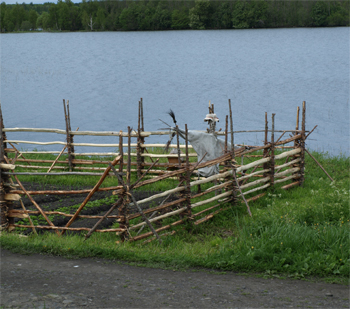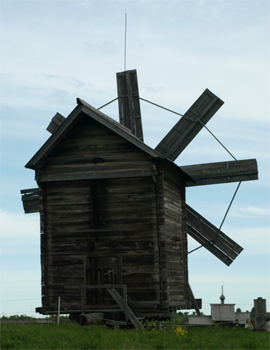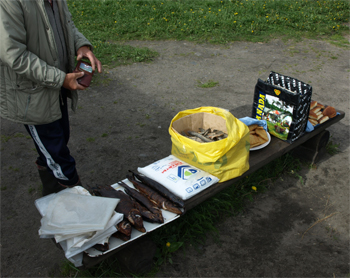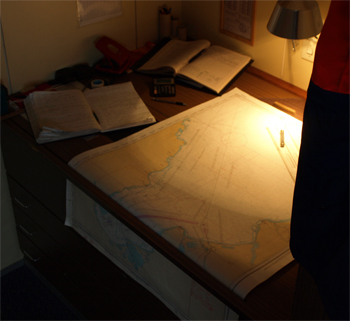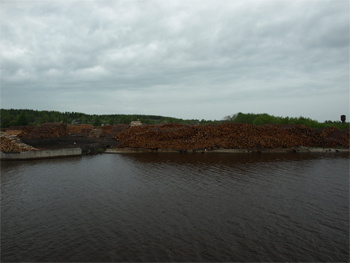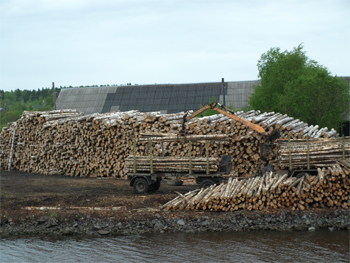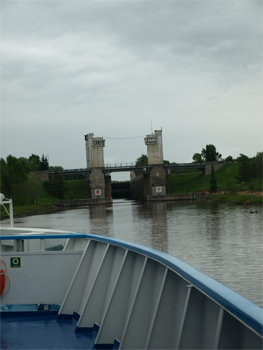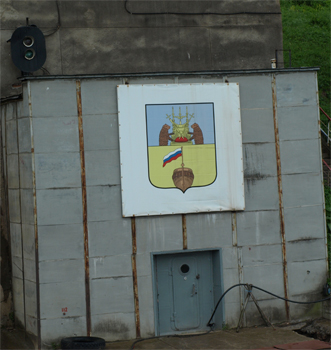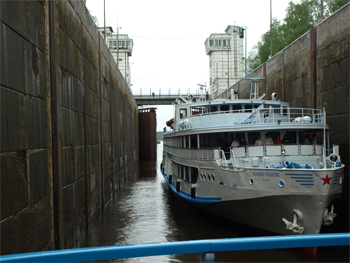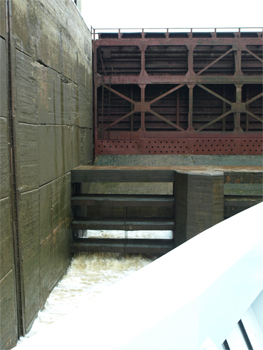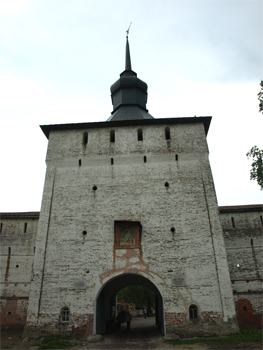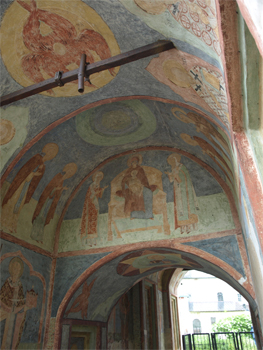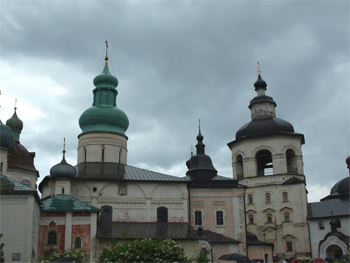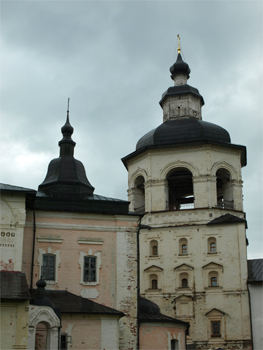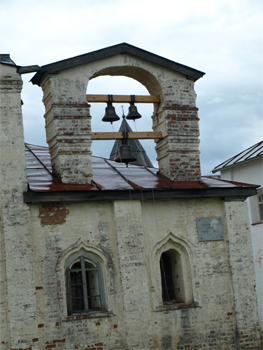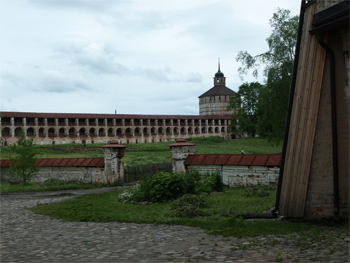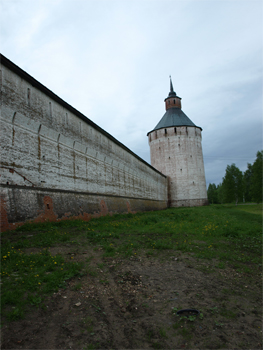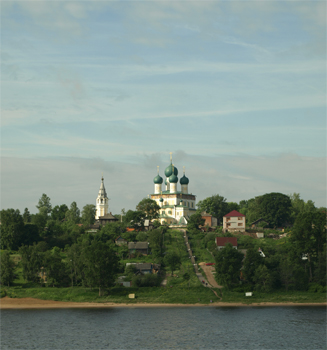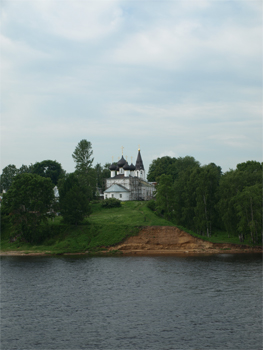At 7:30 AM we landed at the Island of Kizhi, pronounced Kishie. We sailed north on Lake Onega so we are only 300 miles south of the Arctic Circle. It is cold here but the village and walking tour were so interesting we ignored the chill. All of the buildings here - church, farmhouse, barns, sauna - are built without nails or bolts. Even the aspen shingles on the church domes are fitted together by joinery. Kizhi is a UNESCO World Heritage site
Map of the Island of Kizhi in Lake Onega
|
|
Approaching Kizhi and the Cathedral of the Transfiguration |
Cathedral of the Transfiguration
|
The Cathedral of the Transfiguration, used only in warm weather, was closed for restoration but the outside of the building was amazing. The craftsman (one man according to legend) used only an ax to hew the logs. A saw cuts open the pores/channels in the wood while an ax smashes them closed so sap doesn’t run out, the wood doesn’t shrink, moisture can’t flow inside. Insects don’t get in and the wood lasts much longer. Aspen was used on the domes because the wood reflects the sky and sun so the domes take on different shades of color during each day.
|
Cathedral of the Transfiguration
|
We entered the Church of Intercession (used in winter because it was smaller and warmer), saw the four rows of icons (the iconostasis) with the prophets above and Mary and Jesus below. Three men dressed as monks sang a chant for us. We liked their harmony, especially the deep bass. The churchyard had several wooden Russian Orthodox crosses. Research is ongoing to identify the others buried there many years ago. The two churches, a bell tower, and the cemetery lie within a wall forming the “pogost” or churchyard.
|
Church of Intercession
|
Churchyard with Russian Orthodox crosses |
Church of Intercession
|
Next we walked to the authentic farmhouse. The house overlooked the lake and the stables and barn were connected behind it. Two wooden “locks” held the two structures together. The logs of the first floor of the stables could be removed in the summer to open it to the air for the livestock. The structures on the outside of the house all had a purpose. The walkway allowed the women to open and close the shutters from the outside. The doors were low and small to keep out “ill wind.” The fascia was decorated for character and the vertical board signified good weather (sun) and fertility for those who lived there. Several generations (3 or 4) would live in the house. Children and old people slept above the large stove for it was the warmest place. Every unmarried girl had a trunk to be filled with her dowry. She was taught from age 5 to spin, weave, embroider, etc. to make things to give her husband’s family. Pearls were readily available in the lake and the women learned to make intricate and unique necklaces and earrings from them. We walked from the second story living space into the barn and saw some old sleds, a boat, flax to linen equipment, etc. There was a ramp to the second floor so horses could bring the wagons or sleds up into the barn and then be taken back down to the stables below.
|
Two wooden “locks” held the stables and barn together. The logs of the first floor of the stables could be removed in the summer to open it to the air for the livestock.
|
Farmhouse |
Garden with scarecrow
|
The windmill was also unusual. It was built, without nails, on a pivot so it could be turned to face the wind. It could also be turned “by one horse, four men or one woman.” By the way, nails were not used because 7 nails cost the same as one cow back in that day.
|
Wooden windmill
|
We were treated to a playing of the bells in the small church tower by Igor, who researches bell music and ancient bells. It was neat! We could see him pulling the ropes.
|
If you look closely, you can see the guy pulling the bell rope
|
A fourth church on the island was the Church of the Resurrection of Lazarus. It is a small structure with one dome. It was built in the 14th century and is Russia's oldest church. According to legend the church was founded by a Roman Catholic monk named Lazarus, who converted many pagans because of his healing powers.
|
Church of the Resurrection of Lazarus
|
Gale bought a souvenir spoon to remember this unique living museum and we looked at, but did not purchase, the catch of the day.
|
Catch of the day
|
| We sailed from Kizhi at 10 AM. We relaxed until lunch. After lunch we visited the “wheelhouse” of the ship. They still navigate by charts on these lakes and rivers. |  |
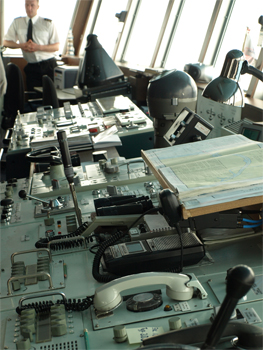 |
The chart room
|
Next we had a lecture on “the Romanovs” - the dynasty of Russian czars from 1613 to 1918 when Nicholas II, his wife and 5 children were murdered in Siberia. The moral is that if Russia had had the political prowess that it had in music, art and literature, Russia would have been the premier country of Europe.
Then Gale went to a cooking demonstration and learned how to make traditional Russian “pelmeni” which is like ravioli or empadillas or perogies. Russian people ate heavy foods because they did heavy work. They ate what was available in the forests - onion, mushroom - and cranberries from the marshes. These were their sources of vitamins. Peter the Great sent back potatoes from Great Britain to improve their food sources but didn’t tell the farmers how to grow them or eat them. Many peasants ate the green buds that are poisonous and died. Later they got it all worked out. I learned that if you put unboiled rice in a cheesecloth sac and put it in salty soup, it will suck out some of the salt, thereby reducing the sodium content. We will have to try that.
Lots of timber
|
|
We went through three more locks today. Some of the gates drop down into the water and some swing like doors. We are amazed at how decrepit the concrete in the locks is. The rebar shows in many places and there is algae on much of it. We went through two or three more locks after we went to bed.
|
Approaching the next lock
|
Coats of arms on either side of the entry to the lock
|
|
Tight fit - the captain doesn't seem to mind when the ship bangs up against the walls of the lock |
At least the locks fill quite rapidly
|
We got up at a leisurely time and took showers in our tiny bathroom.
At 10 AM we listened to a lecture on Russian history from the 1900’s - when Nicholas II was killed ending the Romanov dynasty - until the 1980’s. I learned more European history in that hour than I ever did in high school!
After lunch we docked in Goritzy and joined a local tour guide to visit the Kirillo-Belozersky monastery which was founded in 1397. Of course it rained on us. St. Cyril (of the Cyrillic alphabet fame) had a vision and built this monastery on the banks of Lake Siverskoye. The place is now a museum and houses many very old religious icons from various Russian churches. Some had elaborate gilded silver decorations over the paintings. Some of the walls are frescos, which are in poor shape as are most of the rest of the buildings. The Russian state is helping to restore the significant buildings.
All various views of the Kirillo-Belozersky monastery - which is in need of a lot of restoration - but interesting none-the-less.
|
|
|
|
|
|
|
|
|
|
We got back to the ship in time for traditional Russian tea (and another explanation of the samovar) served with honey and a wide variety of Russian pastries and cookies. We didn’t need the extra calories, but it was very good, especially the tea.
We read and slept until dinner and weren’t the least bit hungry, but ate it all anyway. We have certainly gained weight but we don’t want to miss tasting the Russian food. I had a lamb pilaf and cabbage soup and Marge had the vegetarian baked potato stuffed with mushroom and onion and the spicy pumpkin cream soup.
During dinner we went into a lock and down 46 feet to the Volga River on our way out to Yaroslavl. The sun actually came out this evening and it was quite pleasant out on deck.
| Scenes from along the waterway. |
Resort
|
The ubiquitous Russian church with its onion domes
|
Another church! |
Small town |
Barge traffic
|
| Return to Top | Return to Itinerary | Return to Dreamcatcher Home Page |
